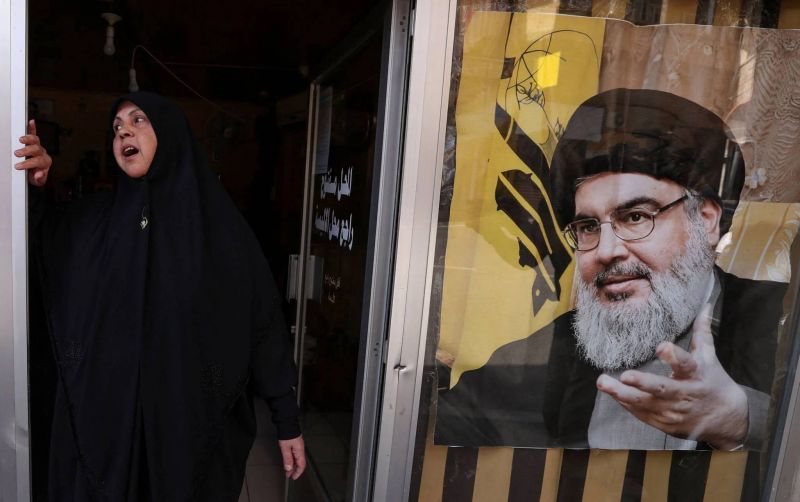
In the village of Qana, on Oct. 24, 2023, a woman stands next to a poster depicting Hezbollah leader Hassan Nasrallah. (Credit: Zohra Bensemra/Reuters)
Click here to follow our live coverage.
While everyone has been wondering where Hassan Nasrallah has gone and why he has kept silent since Oct. 7, Hezbollah’s secretary-general has chosen to respond in his own way: three times in two days.
The Hezbollah leader’s “appearance” over the past few days has been gradual. First, he had a “secure” phone call with Free Patriotic Movement leader Gebran Bassil, during which he reportedly discussed recent developments in Lebanon and the region.
Second, he wrote, by hand, an open letter stating instructions to Hezbollah’s media bodies. In this missive, he called for media outlets to describe Hezbollah’s fighters who have been killed since the start of the “al-Aqsa Flood” operation as “martyrs on the road to Jerusalem.”
This is the same accolade Nasrallah gave to Imad Mughnieh, Hezbollah’s operations chief, after his assassination in Damascus in 2008, in an attack blamed on Israel.
This description carries the connotation that the al-Aqsa Flood operation is one of the battles on the path toward the liberation of Jerusalem, not the final battle.
Speaking on condition of anonymity, sources informed on Hezbollah policy told L’Orient-Le Jour that Hezbollah’s officials and media bodies have also been told to stop talking about “red lines,” which if crossed would mean the party’s official entry into the war against Israel.
It should be recalled that on the offensive’s first days, Hezbollah — through its top officials and Iran’s foreign minister — had threatened to open a new front against Israel in these three cases: a massive ground offensive in the Gaza Strip and the displacement of its population; if there is the risk of annihilating Hamas; or if there is an attack on Iran.
Nasrallah, therefore, wants to have free rein so as not to be forced to wage war at a timing that he himself has not defined, if Israel crosses one of these “red lines.”
The informed sources also told L’Orient-Le Jour that Hezbollah would intervene if Hamas were to be defeated, or even destroyed, militarily and in the event of a major exodus of the Gazan population.
Finally, Nasrallah appeared in a photo Hezbollah released on Oct. 25, alongside Hamas’ second in command Saleh al-Arouri and Palestinian Islamic Jihad head Ziad al-Nakhaleh, at a meeting they held in Beirut. However, the date of the meeting was not specified.
According to the party’s press release, the three men discussed “what the parties of the resistance axis must do at this critical stage to achieve victory ... in Gaza and Palestine.”
In other words, the possibility that Hezbollah opens a new front in the Israel-Hamas war is low. The war is in Gaza, and will remain there, at least for the time being.
This article was originally published in French in L'Orient-Le Jour. Translation by Joelle El Khoury.
